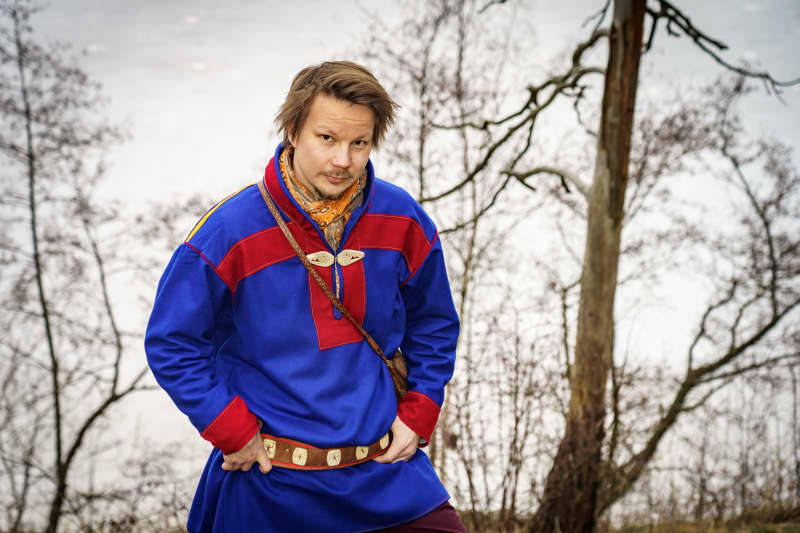
Writer, musician and Sámi activist Niillas Holmberg strives for self-sufficiency. He rhythms the making of art with the cycle of nature.
He is involved in the documentary *10 letters to the future*. In the mosaic-like film, we consider what the world will be like in 2078. Niillas Holmberg is one of the authors of the \”letter\”. He asks what kind of nature is in Tola. Above all, the lands and waters of the north. Does a blanket of snow cover the fells, or is the landscape patchy like on the shores of Töölönlahti?
The concern for the environment is great, because the Sámi culture is closely linked to nature. It is far from the abstract nature relationship of the majority population.
– Our culture is nature-centered, while Western culture is human-centered. There is a significant difference.

Holmberg spends a lot of time in nature, in his native lands. However, he does not wander there relaxing and admiring, the relationship is much more practical. He picks berries, fishes and does handicrafts.
– I strive for self-sufficiency, although it is quite tedious and takes a lot of time.
Writing, music and other art-making must be rhythmic according to the flow of nature. When the berries are ripe, then you have to collect the berries. The rest can stay, because the berries don’t wait.
– In the summer months may pass without me answering e-mails.
The controversy over the Sámi assemblies brought the Sámi people into the spotlight for once
Sámi culture comes out once a year, on the Sámi National Day. As in this story.
However, last year was exceptional. The debate raging around the Sámi assemblies occupied the media for almost the entire rest of the year. The law reform proposal became such a hot topic that the government was toppled.
The law reform process is still in progress, but Niillas Holmberg also saw good in the contentious debate.
– You can say that, for once, the Sámi issue was properly visible. Perhaps the knowledge about the Sámi people also increased.
It is certainly true that before last autumn’s debate, Sámi assemblies were a foreign thing to the vast majority of Finns. The complex and long-running dispute about the right to vote in Sámi assemblies was twisted in many media.
The Sámi are the only indigenous people in the EU region, and their culture and traditional livelihoods must be nurtured. That is why Sámi assemblies should be consulted in matters that affect the Sámi. Because of this, there has been a desire to tighten the right to vote in Sámi assemblies, so that the power remains with the Sámi. It has not pleased those who would lose their right to vote.
Activism through art
Holmberg admits that he is sometimes upset that things are progressing slowly, and that the voice of the Sámi people is still not listened to enough.
Fortunately, there is art. In her first novel, Halla Helle Holmberg, published two years ago, she thoroughly considered the cultural differences between the Sámi and the mainstream population. The novel’s main character from Tampere encounters his own stereotypes about the Sámi when he gets to know Elle, aka Halla Helle. The writing process was instructive for Holmberg as well.
– I recommend everyone to change their perspective from time to time.
Now he has a novel about the same story in the works. The main character this time is Halla Helle, and the point of view is now that of a Sámi. The writing language is again Northern Sami, in which Holmberg has written most of his poetry.

For Holmberg, writing in one’s mother tongue is a social act. There are far fewer potential readers than when writing in Finnish, but Holmberg still wants to write in Sami.
– You can say that I even feel it as a duty.
Despite his young age, Holmberg has already published several works. The first poetry collection was published at the age of 19. A dozen literary works have been published since then. Holmberg has been nominated twice for the Nordic Council’s literature prize.
Homeland does not respect borders
Holmberg is purely Sami in identity. He does not feel that he is Finnish. His homeland is Saami, which extends to Norway, Sweden and Russia. Half of his family is from the other side of Tenojoki, i.e. from Norway.
– It’s strange that the border goes to Tenojoje, which has united nations throughout time. As if I wanted to think that my relatives were foreigners.
Northern Sami is also spoken on the Norwegian side, so communicating with the Sami people of the region is easy. In addition to Northern Sami, Koltan Sami and Inari Sami are spoken in Finland. There are only a few hundred speakers. All in all, about 3,500 Sami people live in the home region of the Sami people.

Niillas Holmberg has lived in the north almost all her life. He went to high school in Tampere, but after that he returned to his home region.
The Sámi national day, which is celebrated tomorrow, February 6, in itself does not mean much to Holmberg, because he is not a \”celebration day person\”. However, as a performing artist, he usually participates in some celebrations.
– Perhaps the best gift of the day is community. Then we gather together even after long distances.
